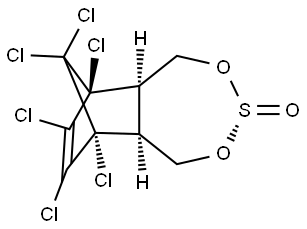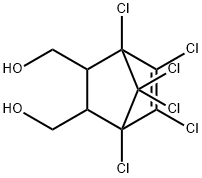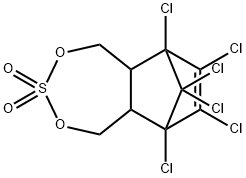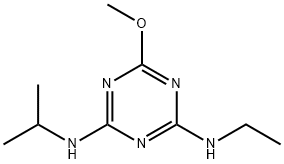Endosulfan I
Synonym(s):α-Endosulfan
- CAS NO.:959-98-8
- Empirical Formula: C9H6Cl6O3S
- Molecular Weight: 406.93
- MDL number: MFCD00151174
- EINECS: 625-034-9
- SAFETY DATA SHEET (SDS)
- Update Date: 2024-10-28 23:16:16

What is Endosulfan I?
Chemical properties
Endosulfan is a chlorinated cyclodiene insecticide. The pure product is a colorless crystalline solid. The technical product is a light to dark brown waxy solid. It has a rotten egg or sulfur odor.
Physical properties
Colorless to brown crystals or flakes with a mild odor similar to terpene or sulfur dioxide.
The Uses of Endosulfan I
Insecticide for vegetable crops.
General Description
Brown crystals.
Air & Water Reactions
Insoluble in water. Slowly hydrolyzes to form sulfur dioxide and diol; hydrolyzes more rapidly under basic or acidic conditions.
Reactivity Profile
Endosulfan I is an organochlorine, cyclodiene derivative. Also a sulfite ester. Incompatible with strong oxidizing and reducing agents. Also incompatible with many amines, nitrides, azo/diazo compounds, alkali metals, and epoxides. As an ester Endosulfan I will hydrolyze to form sulfur dioxide and a diol; reaction is more rapid under basic conditions.
Health Hazard
ACUTE/CHRONIC HAZARDS: Highly toxic by ingestion, inhalation, and skin absorption.
Fire Hazard
Non-combustible, substance itself does not burn but may decompose upon heating to produce corrosive and/or toxic fumes. Containers may explode when heated. Runoff may pollute waterways.
Potential Exposure
Those engaged in the manufacture, formulation, and application of this material
Environmental Fate
Soil. Metabolites of endosulfan identified in soils were endosulfandiol (1,4,5,6,7,7-
hexachlorobicyclo[2.2.1]hept-5-ene-2,3-dimethanol), endosulfan ether, endosulfan lactone
(4,5,6,7,8,8-hexachloro-1,3,3a,4,7,7a-hexahydro-4,7-methane-isobenzofuran-1-one) and
endosulfan sulfate (6,7,8,9,10,10-hexachloro-1,5,5a,6,9,9a-hexahydro-6,9-methano-2,3,4-
benzodioxathiepin-3,3-dioxide) (Martens, 1977; Dreher and Podratzki, 1988). These compounds,
including endosulfan ether, were also reported as metabolites identified in aquatic
systems (Day, 1991). Endosulfan sulfate was the major biodegradation product in soils
under aerobic, anaerobic and flooded conditions (Martens, 1977). In flooded soils, endolactone
was detected only once whereas endodiol and endohydroxy ether were identified in
all soils under these conditions. Under anaerobic conditions, endodiol formed in low
amounts in two soils (Martens, 1977).
Indigenous microorganisms obtained from a sandy loam degraded a-endosulfan to
endosulfandiol. This diol was converted to endosulfan a-hydroxy ether and trace amounts
of endosulfan ether and both were degraded to endosulfan lactone (Miles and Moy, 1979).
Using settled domestic wastewater inoculum, a-endosulfan (5 and 10 mg/L) did not
degrade after 28 days of incubation at 25°C (Tabak et al., 1981).
Plant. Endosulfan sulfate was formed when endosulfan was translocated from the
leaves to roots in both bean and sugar beet plants (Beard and Ware, 1969). In tobacco
leaves, a-endosulfan is hydrolyzed to endosulfandiol (Chopra and Mahfouz, 1977). Stewart
and Cairns (1974) reported the metabolite endosulfan sulfate was identified in potato peels
and pulp at concentrations of 0.3 and 0.03 ppm, respectively. They also reported that the
half-life for the conversion of a-endosulfan to b-endosulfan was 60 days. On apple leaves,
direct photolysis of endosulfan by sunlight yielded endosulfan sulfate (Harrison et al.,
1967).
In carnation plants, the half-lives of a-endosulfan stored under four different conditions,
non-washed and exposed to open air, washed and exposed to open air, non-washed
and placed in an enclosed container and under greenhouse conditions were 6.79, 6.38,
10.45 and 4.22 days, respectively (Céron et al., 1995).
Surface Water. Endosulfan sulfate was also identified as a metabolite in a survey of
11 agricultural watersheds located in southern Ontario, Canada (Frank et al., 1982). When
endosulfan (a- and b- isomers, 10 mg/L) was added to Little Miami River water, sealed
and exposed to sunlight and UV light for 1 week, a degradation yield of 70% was observed.
After 2 and 4 weeks, 95% and 100% of the applied amount degraded. The major degradation
product was identified as endosulfan alcohol by IR spectrometry (Eichelberger and
Lichtenberg, 1971).
Photolytic. Thin films of endosulfan on glass and irradiated by UV light (l >300 nm)
produced endosulfandiol with minor amounts of endosulfan ether, a lactone, an a-hydroxyether
and other unidentified compounds (Archer et al., 1972). When an aqueous solution
containing endosulfan was photooxidized by UV light at 90–95°C, 25, 50 and 75%
degraded to carbon dioxide after 5.0, 9.5 and 31.0 hours, respectively (Knoevenagel and
Himmelreich, 1976).
Chemical/Physical. Endosulfan slowly hydrolyzes forming endosulfandiol and
endosulfan sulfate (Kollig, 1993; Martens, 1976; Worthing and Hance, 1991). The hydrolysis
rate constant for a-endosulfan at pH 7 and 25°C was determined to be 3.2 ′ 10–3/hour,
resulting in a half-life of 9.0 days (Ellington et al., 1988). The hydrolysis half-lives are
reduced significantly at varying pHs and temperature. At temperatures (pH) of 87.0 (3.12),
68.0 (6.89) and 38.0°C (8.69), the half-lives were 4.3, 0.10 and 0.08 days, respectively
(Ellington et al., 1986). Greve and Wit (1971) reported the hydrolysis half-lives of a-
endosulfan at 20°C and pH values of 7 and 5.5 were 36 and 151 days, respectively.
Emits toxic fumes of chlorides and sulfur oxides when heated to decomposition (Lewis,
1990).
Shipping
UN2761 Organochlorine pesticides, solid, toxic, Hazard Class: 6.1; Labels: 6.1-Poisonous materials. UN2811 Toxic solids, organic, n.o.s., Hazard Class: 6.1; Labels: 6.1-Poisonous materials, Technical Name Required.
Incompatibilities
Those engaged in the manufacture, formulation, and application of this material
Waste Disposal
A recommended method for disposal is burial 18 in deep in noncropland, away from water supplies, but bags can be burned. Large quantities should be incinerated at high temperature in a unit with effluent gas scrubbing. Consult with environmental regulatory agencies for guidance on acceptable disposal practices. Generators of waste containing this contaminant (≥100 kg/ mo) must conform with EPA regulations governing storage, transportation, treatment, and waste disposal. In accordance with 40CFR165, follow recommendations for the disposal of pesticides and pesticide containers. Must be disposed properly by following package label directions or by contacting your local or federal environmental control agency, or by contacting your regional EPA office.
Properties of Endosulfan I
| Melting point: | 109°C |
| Boiling point: | 449.7±45.0 °C(Predicted) |
| Density | 1.94 |
| vapor pressure | 4.58 x 10-5 mmHg at 25 °C (subcooled liquid vapor pressure calculated from GC retention time data,Hinckley et al., 1990) |
| Flash point: | -26 °C |
| storage temp. | APPROX 4°C
|
| solubility | Chloroform: Slightly soluble; DMSO: Slightly soluble; Methanol: Slightly soluble |
| form | neat |
| Water Solubility | (mg/L): 0.51 at 20 °C (shake flask-GC, Bowman and Sans, 1983) 0.53 at 25 °C (extraction-GLC, Weil et al., 1974) |
| BRN | 2950316 |
| Henry's Law Constant | 0.266 at 5 °C, 0.464 at 15 °C, 0.711 at 20 °C, 0.809 at 25 °C, 1.09 at 35 °C; in 3% NaCl solution:1.07 at 5 °C, 2.08 at 15 °C, 4.71 at 25 °C, 6.71 at 35 °C (gas stripping-GC, Cetin et al., 2006) |
| Exposure limits | ACGIH TLV: TWA 0.1 mg/m3. |
| Stability: | Light Sensitive |
| NIST Chemistry Reference | Endosulfan i(959-98-8) |
| EPA Substance Registry System | .alpha.-Endosulfan (959-98-8) |
Safety information for Endosulfan I
| Signal word | Danger |
| Pictogram(s) |
 Skull and Crossbones Acute Toxicity GHS06  Environment GHS09 |
| GHS Hazard Statements |
H312:Acute toxicity,dermal H410:Hazardous to the aquatic environment, long-term hazard |
| Precautionary Statement Codes |
P273:Avoid release to the environment. P280:Wear protective gloves/protective clothing/eye protection/face protection. |
Computed Descriptors for Endosulfan I
New Products
4-AMINO-TETRAHYDRO-PYRAN-4-CARBOXYLIC ACID HCL 4-(Dimethylamino)tetrahydro-2H-pyran-4-carbonitrile 4-Aminotetrahydropyran-4-carbonitrile Hydrochloride (R)-3-Aminobutanenitrile Hydrochloride 3-((Dimethylamino)methyl)-5-methylhexan-2-one oxalate 1,4-Dioxa-8-azaspiro[4.5]decane 5-Bromo-2-nitropyridine Nimesulide BP Aceclofenac IP/BP/EP Diclofenac Sodium IP/BP/EP/USP Mefenamic Acid IP/BP/EP/USP Ornidazole IP Diclofenac Potassium THOMAIND PAPER PH 2.0 TO 4.5 1 BOX BUFFER CAPSULE PH 9.2 - 10 CAP SODIUM CHLORIDE 0.1N CVS ALLOXAN MONOHYDRATE 98% PLATINUM 0.5% ON 3 MM ALUMINA PELLETS (TYPE 73) LITHIUM AAS SOLUTION 2-Bromo-1-(bromomethyl)-3-chloro-5-nitrobenzene 2-Bromo-3-nitroaniline N-(3-Hydroxypropyl)-N-methylacetamide 3-Bromo-6-chloropyridazine 4-ethyl-3-nitrobenzoic acidRelated products of tetrahydrofuran








You may like
-
 1-Methyl-6-oxo-1,6-dihydropyridazine-3-carbonitrile 98%View Details
1-Methyl-6-oxo-1,6-dihydropyridazine-3-carbonitrile 98%View Details
99903-60-3 -
 88491-46-7 98%View Details
88491-46-7 98%View Details
88491-46-7 -
 1823368-42-8 98%View Details
1823368-42-8 98%View Details
1823368-42-8 -
 2-(3-(tert-butyl)phenoxy)-2-methylpropanoic acid 1307449-08-6 98%View Details
2-(3-(tert-butyl)phenoxy)-2-methylpropanoic acid 1307449-08-6 98%View Details
1307449-08-6 -
 Ethyl 3-(furan-2-yl)-3-hydroxypropanoate 25408-95-1 98%View Details
Ethyl 3-(furan-2-yl)-3-hydroxypropanoate 25408-95-1 98%View Details
25408-95-1 -
 2-Chloro-5-fluoro-1-methoxy-3-methylbenzene 98%View Details
2-Chloro-5-fluoro-1-methoxy-3-methylbenzene 98%View Details
1805639-70-6 -
 1784294-80-9 98%View Details
1784294-80-9 98%View Details
1784294-80-9 -
 Lithium ClavulanateView Details
Lithium ClavulanateView Details
61177-44-4